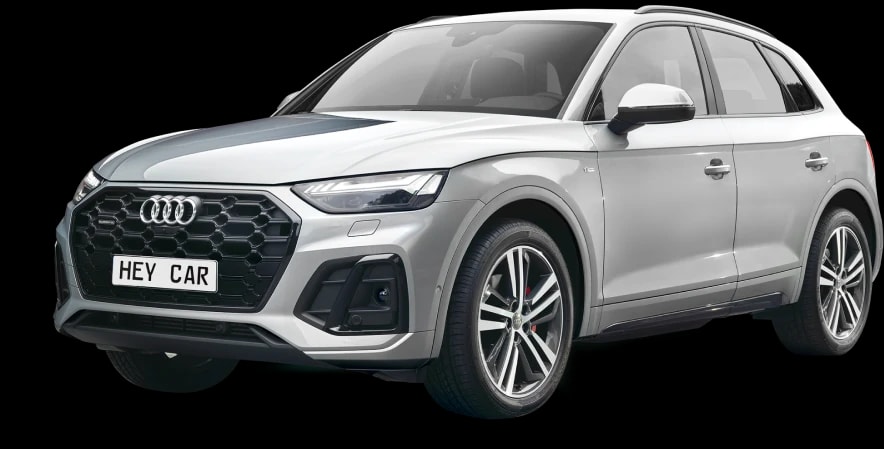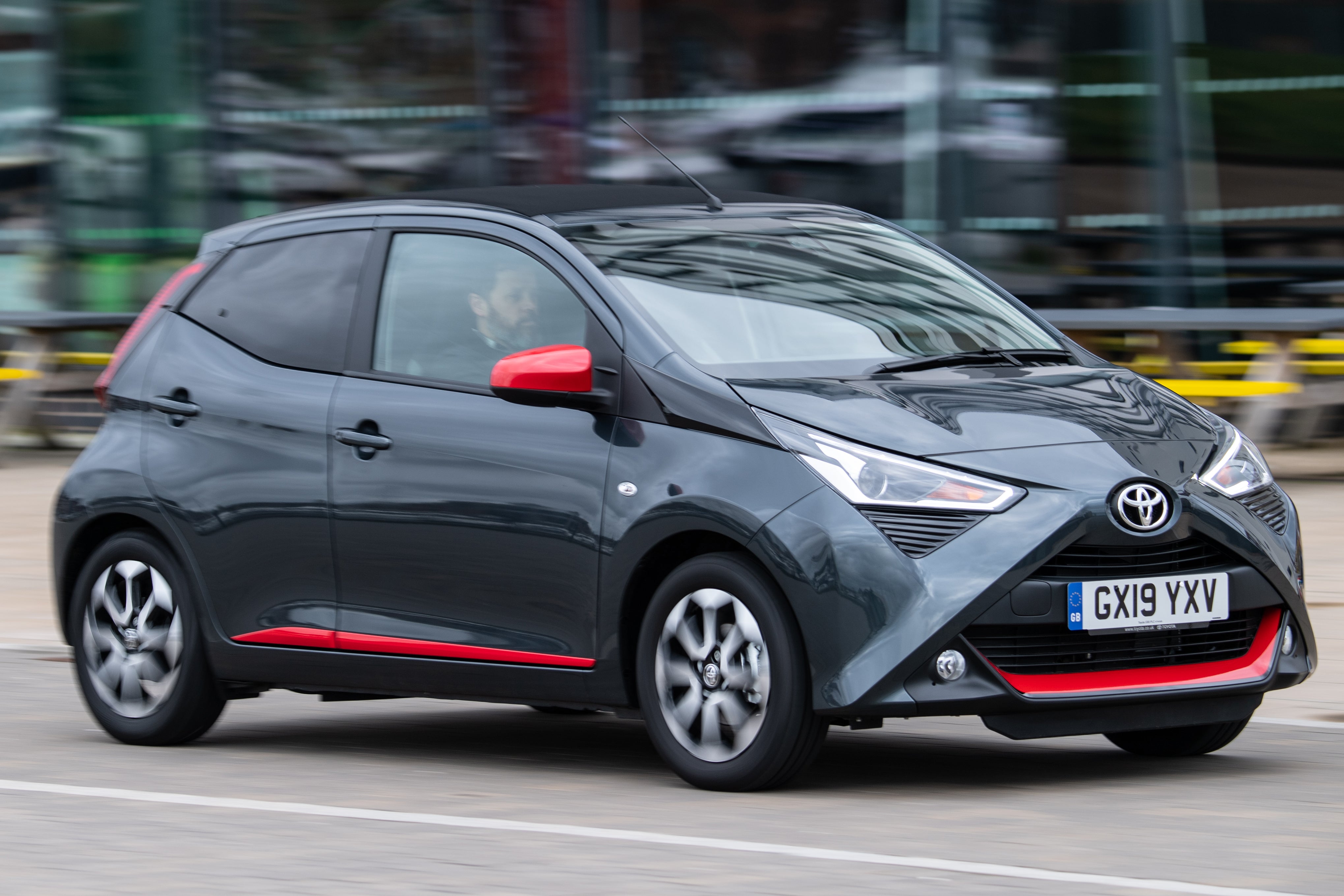Toyota Aygo (2014-2022) Review
Written by Andrew Brady
Quick overview
Pros
- Low effort to drive in the city
- Good specification other than basic model
- Low running costs
Cons
- Not much space for rear-seat passengers
- Adequate motorway performance
- Automatic gearbox hampers the Aygo’s performance
Overall verdict on the Toyota Aygo
"There’s not much to choose between the Toyota Aygo and its sibling rivals (the Citroen C1 and Peugeot 108), but the Toyota is arguably the best-looking of the three and has good dealer service to fall back on, too. In x-play trim, it is well-equipped, a breeze to drive and cheap to run."
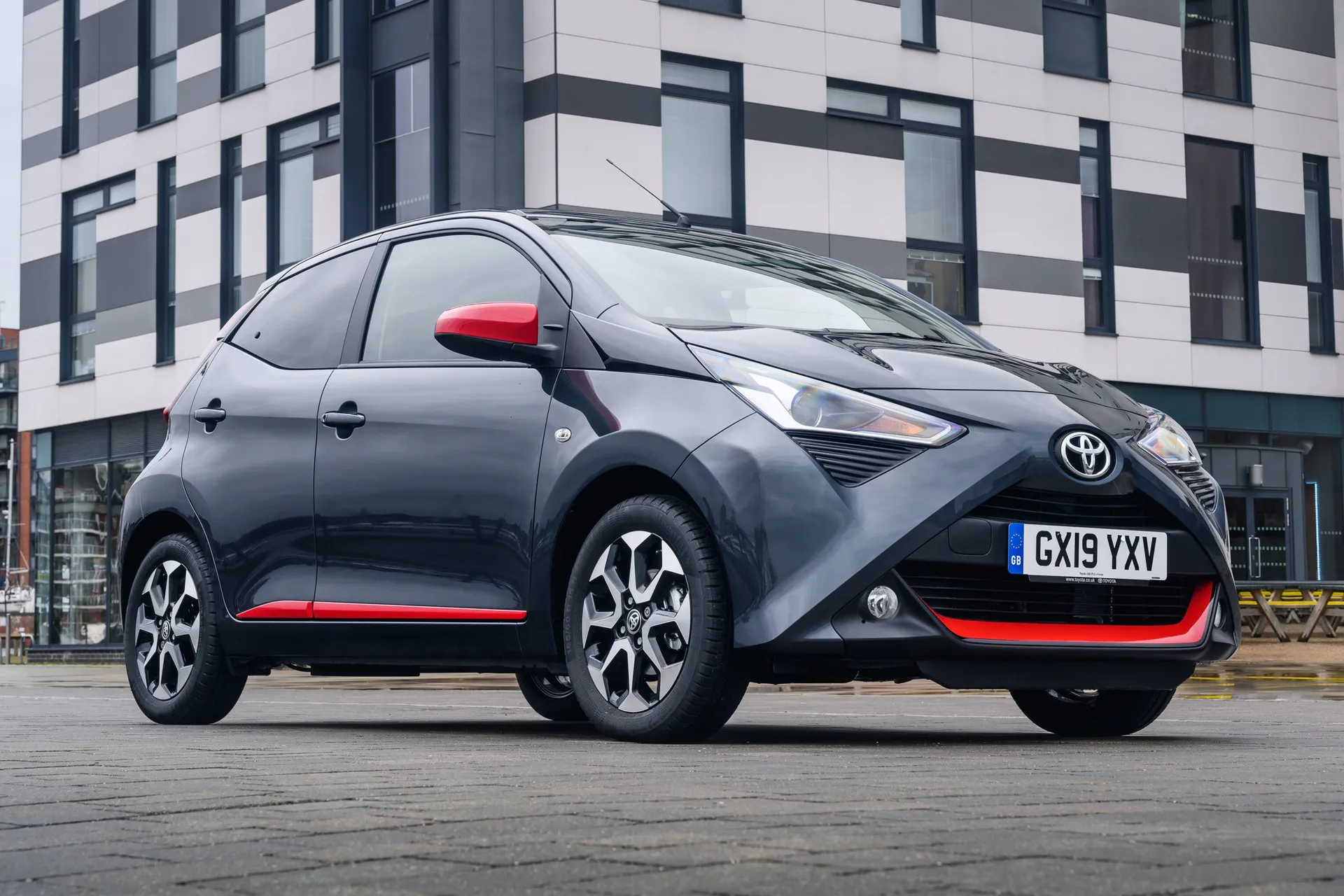
Modern city cars have a hard time these days. It used to be that they weren’t suitable for anything other than urban dashes, but now the expectations of buyers are higher than ever before, and Toyota has played a big part in that.
The original Toyota Aygo appeared in 2005, and although it was still a cheap car, it felt more sophisticated than its key rivals and proved popular as a result. A second-generation car arrived in 2014 and brought with it significant upgrades including numerous safety features not available on the original model, making it one of our favourite city cars. We'll explain why in our Toyota Aygo review.
Both generations of Toyota Aygo were part of a collaboration between Peugeot, Citroen and Toyota, with each manufacturer producing their own version of the car, differentiated only by some design details and specification. Small cars cost almost as much as bigger cars to design and build, but have to sell for much less money, so the joint effort reduced development costs and allowed the final product to be more sophisticated and of better quality as a result.
The Toyota Aygo range is simple in terms of the big decisions - another element that helps keep prices low - with a single petrol engine option, three- or five-doors and a choice of manual or automated manual gearboxes. Of course, the Aygo is small in its exterior dimensions at under 3.5 metres in length, although it maximises the available interior space thanks to its tall body and short overhangs. To keep costs down and save a little space, the rear windows on all versions are hinged to open rather than rolling down in the conventional manner.
You may be surprised to discover how much space is available in the Toyota Aygo when you step inside. Front seat passengers are particularly well served, with generous legroom and decent headroom thanks to the height of the roof. There’s considerably less legroom available in the rear, so adults using the back seats will want to keep journeys short. The boot is also relatively small, although far from the smallest in the class.
On the inside, the Toyota Aygo’s interior is relatively simplistic in its design, but it is attractive and feels of decent quality for a car at this price point. Even in the basic Toyota Aygo x model with the least equipment and the most plain trim, there’s still a strong sense that this is a car that has been well-designed and built to last. Move up the Aygo range, however, and the visual appeal increases; Toyota offers a wide range of personalisation options that allow you to put your own spin on the cabin.
The Toyota Aygo has a single engine option, a 1.0-litre petrol three-cylinder unit with a modest 72PS. The upside is that the Aygo has been built with low weight in mind, and tips the scales at only 840kg, so it offers decent performance despite the small engine.
Although the Aygo is best suited to town driving, there’s enough performance available to make motorway journeys a viable prospect. It’s also impressively economical, with a claimed fuel consumption figure of 57.7mpg in WLTP tests, so you should be able to achieve 50mpg in the real world.
Easy to drive, cheap to run and not very expensive to buy, the Toyota Aygo is a great example of the modern city car. It delivers everything you could reasonably need, but also manages to perform beyond its brief.
Looking for a used car for sale? We've got 100s of Toyota Approved Used Cars for Sale for you to choose from, including a wide range of Toyota Aygos for sale.
Is the Toyota Aygo right for you?
The Toyota Aygo in particular is aimed squarely at new drivers, and as well as meeting the specific requirements of that demographic - easy to drive, cheap to insure and cheap to fuel - it also manages to throw in a few bonus elements. It has a strong exterior design, plenty of scope for personalisation and a fun driving experience. There’s a lot here to keep inexperienced drivers happy.
The Toyota Aygo doesn’t have the same quality feeling as the Volkswagen Up, or the space efficiency and driving pleasure of the Hyundai i10, but it is very good value and is likely to be a reliable ownership prospect, too.
What’s the best Toyota Aygo model/engine to choose?
With only one engine to choose from, there’s not much to consider in this department. Most models are fitted with a five-speed manual gearbox as standard, but there is an automated manual five-speed available as an option. It’s acceptable if you really have to have an auto, but it blunts the modest performance even further.
The basic Toyota Aygo x really is basic: standard equipment amounts to electric windows, daytime LED running lights, a USB connector for your phone, and that’s about it. Best to at least move up to the x-play version, which is a mile away in terms of extra kit. You get manual air conditioning, a height-adjustable driver’s seat, a leather steering wheel, heated door mirrors, a reversing camera, two extra speakers, Bluetooth phone integration and the x-touch media system.
There are still-fancier models above the x-play, but the extra kit you get isn’t worth the extra financial outlay in our book.
What other cars are similar to the Toyota Aygo?
There are two obvious candidates here that are more similar than anything else - the Citroen C1 and Peugeot 108 - which would be hard to tell apart other than the price tag and exterior looks. It’s worth considering all three and buying the one you find the best deal on.
The SEAT Mii and Skoda Citigo are Volkswagen Group spin-offs of the Volkswagen Up, and bring the solid engineering and efficiency you get with the Volkswagen, just with a smaller price tag. Smart-looking and good to drive, both the Mii and Citigo are attractive options.
The Hyundai i10 is one of the best city cars in the class, with impressive space efficiency and a good driving experience, and it's good value, too.
Comfort and design: Toyota Aygo interior
"Even if you’re paying as little as possible for a small car like this, it doesn’t mean you should have to forgo any semblance of comfort."
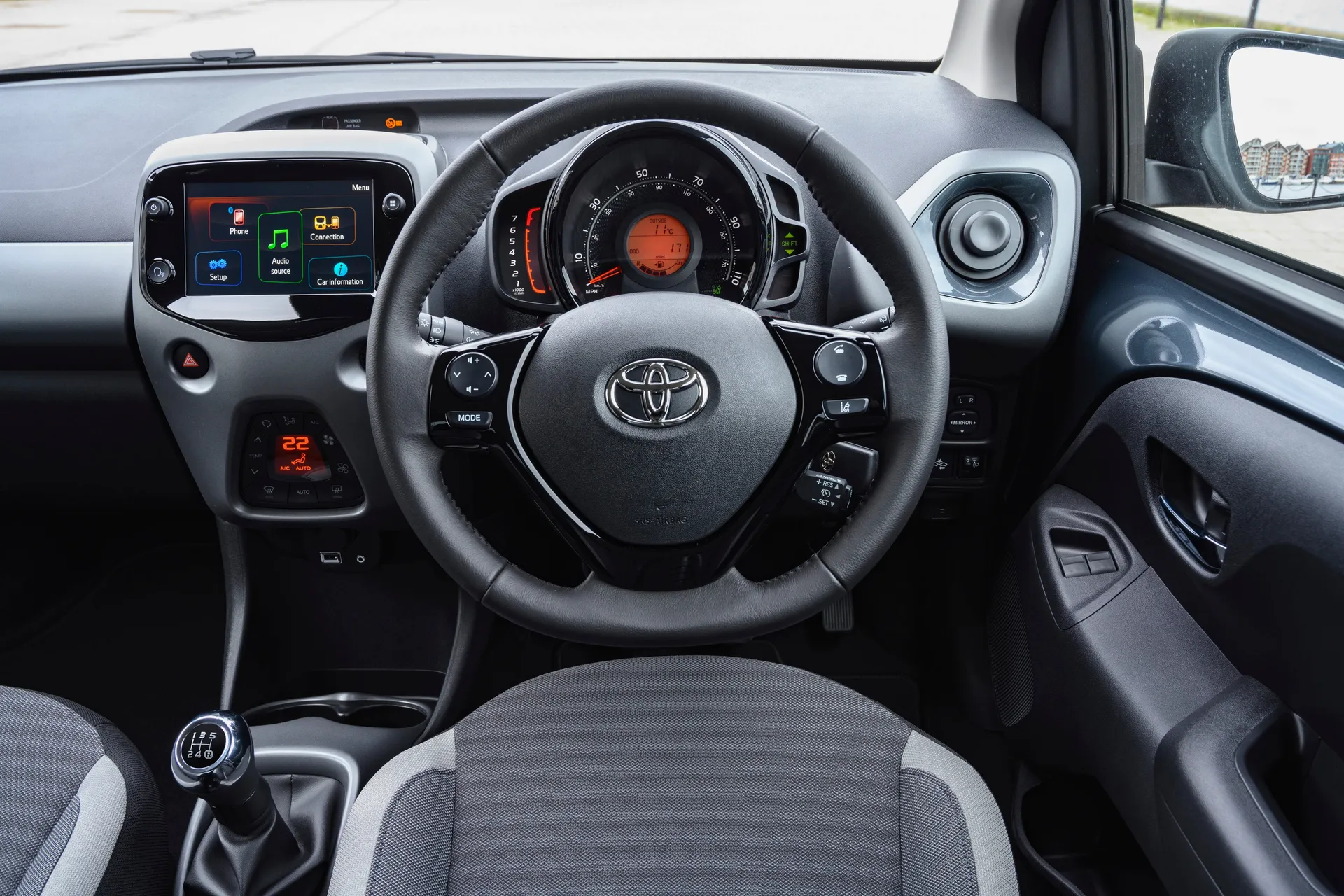
Happily the Toyota Aygo is amongst the better offerings in the class, and is capable of accommodating all sizes and shapes with ease. As long as you choose a model other than the most basic Aygo x, the driver’s seat comes with height adjustment, and although the wheel only adjusts for height, no one should struggle to find a good driving position. The seats themselves are above the class standard, too, with good support for a variety of body shapes and decent lateral support, something that is frequently lacking in low-cost small cars.
The main controls and displays are straightforward but attractive, and all grouped closely around the driver in an appealing fashion. A large central speedometer includes a digital display that shows your fuel level and the outside temperature, while the rev counter and warning lights sit on either side.
The pleasingly chunky steering wheel also holds controls for the infotainment system (depending on the model), which itself is well-placed and easy to operate.
The driver enjoys a good view out thanks to the generously-sized windows. The low nose means the end of the bonnet drops away quickly so shorter drivers may find it hard to judge when parking, but at the rear the near-vertical tailgate and very short overhang means reversing into a space is easy.
Quality and finish
You shouldn’t get into an Aygo and expect luxury, even if you stump up for the top-spec model. However, what you do get is a cabin that is built from (mostly) decent materials and is built well: it feels like it will stand up to pretty much whatever you could throw at it.
Go for the entry-level Aygo x, though, and there’s not much to cheer about. Not only does that mean the least amount of equipment - expect to adjust your door mirrors with a stick rather than a button - but also a cabin that’s largely devoid of colour. Pretty much everything is finished in grey, except for where the exterior paint is shown across the tops of the doors.
It’s much better the further up the range you go. A single step upwards to the x-play trim gets you smarter seat fabric and more colour on the dashboard, and you can supplement this with a centre console pack that adds a coloured surround to the gearlever housing and the centre console in a choice of shades.
The materials are designed to be hard-wearing rather than particularly plush, but the mix of colours and textures means it doesn’t feel like a solid lump of dark plastic, and it’s clearly put together well. The whole car is designed to be lightweight but it never feels insubstantial, which is good news if you plan to hang on to it for a few years.
Infotainment: Touchscreen, USB, nav and stereo in the Toyota Aygo
Go basic, and your Toyota Aygo x comes with a very functional system amounting to an AM/FM radio with a USB input and two speakers. That might be sufficient if you're really not fussy about your tunes, but otherwise you might regret not spending a bit more for something a little more sophisticated.
Every other model in the range gets a 7.0-inch touchscreen system with lots of attractive functions. It comes with DAB, USB input, an extra pair of speakers to give you four in total and controls on the steering wheel. It’s designed to work hand-in-hand with smartphones, too.
There’s Bluetooth for hands-free calling and streaming, and the option of a companion app for sat-nav. You can skip that completely and take advantage of Apple CarPlay or Android Auto, so it delivers everything you could reasonably expect at this price point.
It all works well, too. The screen feels tough and has a slightly matte finish, which bodes well for thousands of miles of prodding fingers, while it’s easy to navigate through the screens and it rarely suffers from lag.
Space and practicality: Toyota Aygo boot space
Realistic expectations are the order of the day here. The city car class is essentially a collection of the smallest cars that money can buy, but that won’t stop people trying to load them to the gills with people and stuff. That said, the Aygo does offer a reasonable amount of space considering the context, particularly for those sat up front. For stats fans, the Toyota Aygo measures 3455mm long and 1615mm wide.
Big doors on the three-door version mean a massive aperture to climb through so getting in is a breeze. Even getting into the rear seats is almost as easy on the three-door as it is on the five-door, so there’s a strong case for choosing the cheaper option depending on your needs: the lack of space in the footwell means entry isn't as easy as you might expect on the five-door.
Elbow room is a little less plentiful, but unless both you and your passenger are bouncers or are particularly fond of 1980s fashion it shouldn’t be a problem.
In the rear the news is less good, with legroom in particular lacking for adults and even older children. Even if you just have small children in the rear, add in the bulk of a car seat and you’ll find them putting their feet up on the back of the front seats in no time. Headroom is acceptable in the rear, although it’s not quite as generous as in front. Choose the optional sunroof and headroom is reduced still further.
As for boot space, the Toyota Aygo offers 168 litres - considerably less than most of the competition and even less than the Citroen C1 and Peugeot 108, which are essentially identical - which can be an issue if you regularly need to carry stuff. Drop the rear seats, and you have 812 litres on offer, which is at least closer to the class average.
Storage in the cabin is acceptable, with a well-sized glovebox but relatively slim door pockets: not a surprise given how narrow the Toyota Aygo is. There are rivals that offer more space, in particular the Hyundai i10, but overall the Aygo is at least on par with the class average.
Handling and ride quality: What is the Toyota Aygo like to drive?
"It's entirely appropriate that city cars are designed to mop up the worst surfaces that rubbish urban roads can throw at them rather than being B-road weapons, and so it is with the Toyota Aygo."
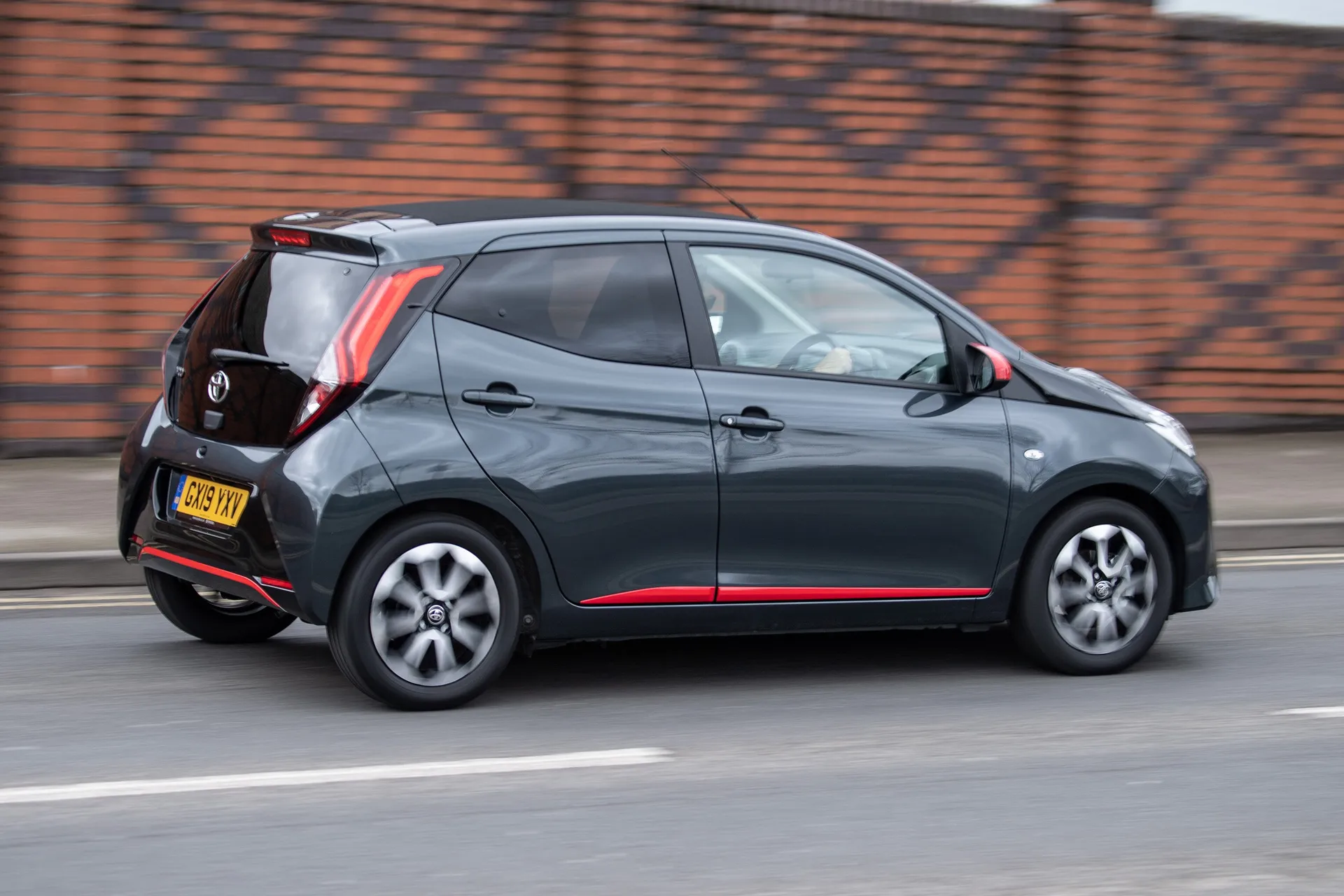
The steering is well-weighted, so it is light enough when parking but has enough weight at higher speeds to make for comfortable cruising. It's reasonably quick, too, so if you’re making tight turns in town, you won’t have your elbows flying too much as you go from lock to lock. Like most cars of this size, you need a steady hand in strong crosswinds, but it’s rare that the Toyota Aygo feels anything other than secure on the road.
As for ride quality, the Toyota Aygo does a pretty good job given its size and wheelbase. It’s harder for shorter cars to deal with bigger bumps because the gap between the front and rear wheels (the wheelbase) is smaller, but the Aygo manages to cope with most conditions well. It’s not exactly a magic carpet ride, and bigger bumps tackled at speed do make their presence felt in the cabin, but for the most part you won’t be upset by the ride quality.
Because it’s (quite rightly) biased towards ride quality, should you choose to start chucking the Aygo around like you stole it, it gets out of its comfort zone quite quickly. It will tolerate this kind of approach but there’s a considerable amount of body roll, not helped by the fact that this is quite a tall car for its length, and the seats are not designed to cope with high cornering forces, either. It feels safe and secure enough so it won’t get the inexperienced driver into trouble, though.
What engines and gearboxes are available in the Toyota Aygo?
The sole engine option in the Toyota Aygo is a trusty 1.0-litre, three-cylinder unit, willingly putting out 72PS and 93Nm of torque. That’s not a great deal, but it is pretty much what most of its rivals provide, and because the Aygo is also light - 840kg is exactly 200kg less than the one-size-bigger Toyota Yaris - it’s not quite as slow as the modest power output would suggest.
What also helps is that the three-cylinder unit is characterful. It sounds much more engaging than a four-cylinder engine of a similar capacity, and although it makes its presence felt as it thrums away in front of you, it manages to avoid being overly raucous unless you thrash it to the maximum.
The Toyota Aygo is at its best in the city, where it can get away from the traffic lights smartly and is quick enough to keep up with urban traffic. Out on quicker country roads or the motorway, you may need a little more patience, but wind it all the way up and it will do 99mph, so has more pace than you need.
The standard five-speed manual gearbox won’t cause you any problems, either. It has a light feel when you change gears and could be more accurate, but the actual gear ratios are well-chosen to give decent acceleration without running out of puff at higher speeds. There is an automatic option for the Aygo, but this is an automated manual gearbox rather than a torque converter or dual-clutch type, and is best avoided; the slow changes blunt the performance and leave the Toyota Aygo feeling slower than it really is.
Refinement and noise levels
For a car of this size and status, the Toyota Aygo does a decent job of keeping your eardrums and your sanity intact. For starters, that three-cylinder engine does create a little bit of noise when you start to exercise it, but it’s a pleasing sound rather than a cacophonous one and doesn’t become excessive unless you really wring it out.
Much the same applies to the levels of wind- and tyre noise. The skinny tyres fitted to most models certainly help with the latter, and while the Aygo isn’t big enough to pack in lots of sound deadening, you don’t feel like you’re being battered by the elements outside. Wind noise picks up a little when you get up to motorway speeds, but the same goes for most of its rivals, and in truth, this will likely only be an occasional occurrence.
Safety equipment: How safe is the Toyota Aygo?
The Aygo was last tested by Euro NCAP in 2017, and was given two separate ratings depending on the safety equipment provision. The basic version was awarded three stars overall, with 74% for adult protection, 63% for child protection, 64% for pedestrian mitigation and 25% for safety assist. The Aygo with the safety pack was given four stars overall, with increased scores of 82% for adult protection and 57% for safety assist.
As standard, all versions of the Toyota Aygo are fitted with LED daytime running lights, six airbags, a tyre pressure warning system, hill start assist and Toyota’s version of ESC (called Vehicle Stability Control). Also fitted to all models are seatbelt pre-tensioners and load limiters, ISOFIX car seats fixings and seat belt reminders.
The Safety Sense pack includes the features EuroNCAP required for the four star overall rating. The pack adds lane departure warning with alert, but more crucially it includes automatic emergency braking. It’s important to note this pack wasn't available on the most basic Aygo x, but was standard on the top-spec x-clusiv and optional on all others, so keep a look out for it on any used example you're considering. You could also add rear parking sensors on some models.
MPG and fuel costs: What does a Toyota Aygo cost to run?
Low running costs are one of the biggest plus points of running a city car, and the Toyota Aygo doesn’t disappoint. As long as you go for a manual gearbox you should be able to crack 50mpg without trying: the official WLTP fuel consumption figures say it is capable of up to a combined 56.4mpg.
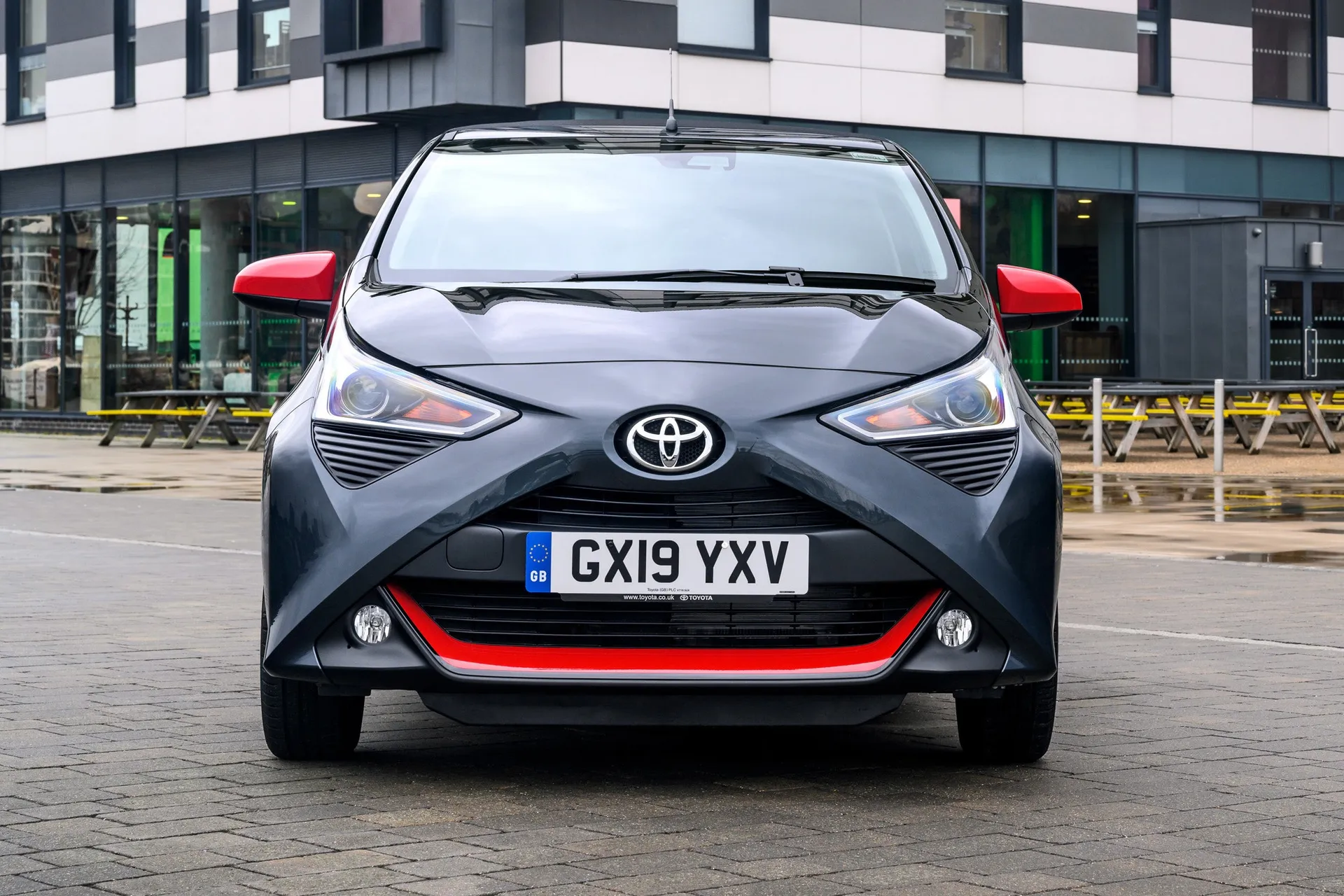
Driven with care, the Toyota Aygo will deliver impressive fuel consumption figures on a regular basis, but it’s worth remembering that because of its modest performance, if you thrash it to get where you’re going more quickly, it will drink more fuel as a result.
How reliable is the Toyota Aygo?
One of the big selling points of a Toyota is its reliability. If you're looking for many years of solid service, Toyota is the brand to go for. In the 2023 HonestJohn.co.uk Satisfaction Index, the Japanese carmaker finished fourth in the list of the most reliable brands (sister brand Lexus came top, as always), and ranked sixth (out of 29) for overall satisfaction.
The Aygo follows that theme, with very few common issues reported, making it a sensible buy if reliability is one of your top considerations.
Another big bonus of Toyota ownership is the warranty you get. It starts off as a bog-standard three-year, 60,000-mile agreement, but get you car serviced at an authorised Toyota dealership, and you'll get a one-year or 10,000-mile warranty extension free of charge, up to a maximum of ten years, or 100,000 miles. Best of all, this applies whatever your car's previous service history.
Insurance groups and costs
Low insurance groupings are essential for the young drivers that cars like this appeal to, purely because young or inexperienced drivers are charged so much for insurance. It's great news, then, that all Aygos have a single-figure grouping. They start at group 5 and rise up to group 9, with the vast majority of versions sitting in between. That means that the Aygo will be among the most affordable cars to insure for those with not much on-road experience.
VED car tax: What is the annual road tax on a Toyota Aygo?
The prevailing message here is that if you want to save cash on road tax, then buy an Aygo built before March 31st 2017. Before that date, annual road tax was calculated on a car's CO2 emissions, and the Aygo's were low enough that owners paid nothing at all on any version.
After that date, the rules changed so that drivers were charged a flat rate on all petrol and diesel cars. That rate currently stands at £190 per year.
How much should you be paying for a used Toyota Aygo?
"The Aygo was a very popular car, and even just looking at the second generation models from 2014, there are stacks to choose from."
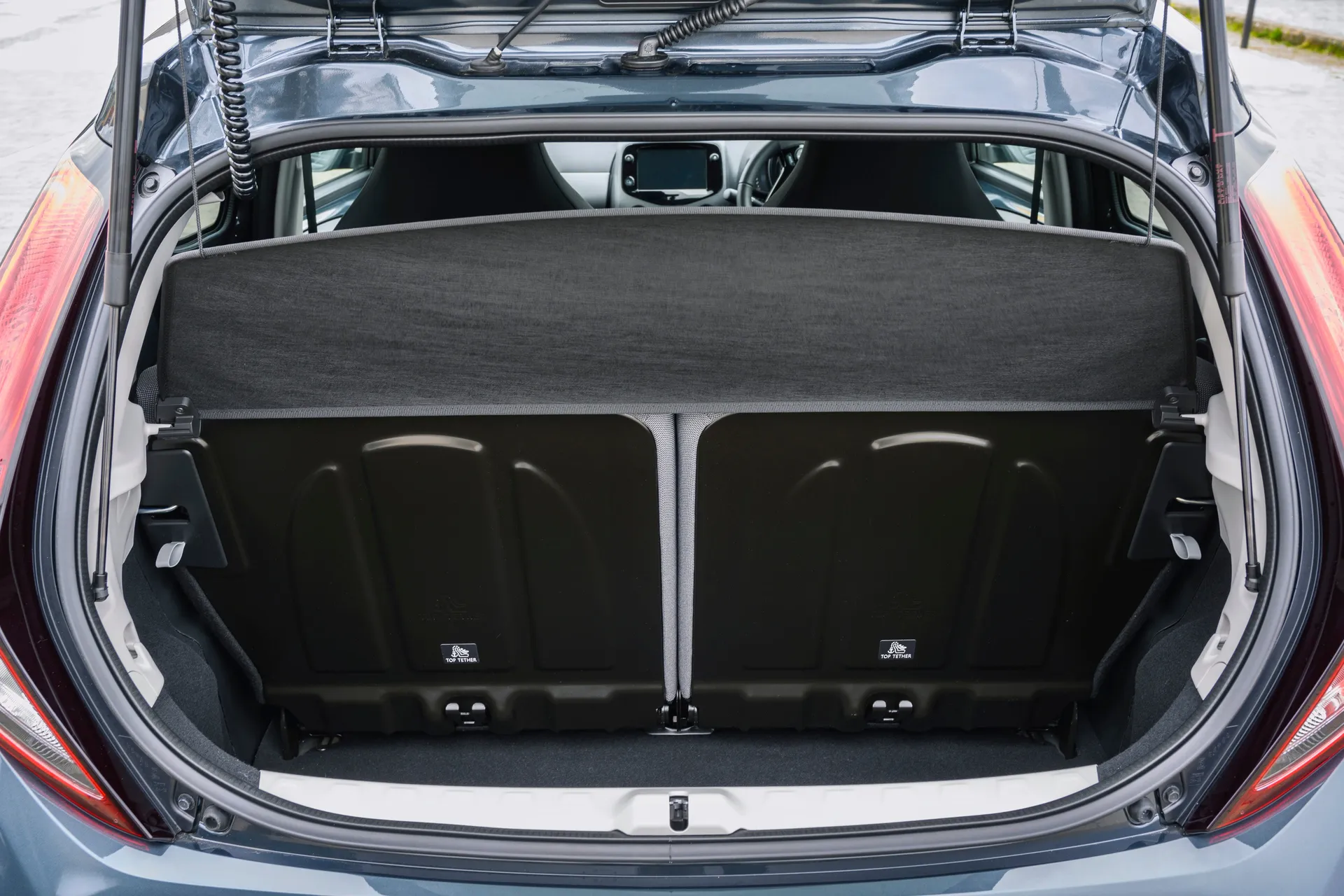
The Aygo was withdrawn from sale as a new car in 2022, and replaced by the SUV-styled Aygo X, so if you want the second-generation one we're talking about here, you'll need to look to the used car market.
The cheapest examples in our classifieds (bearing in mind cars offered for sale on our website can be a maximum of eight years old) are cars wearing between 30-50,0000 miles, and these are offered for around the seven grand mark. Get it serviced at a Toyota dealer, and a car like this can still carry a good chunk of warranty.
If you're after something a bit newer, you can have a 2022 example in a mid-spec trim with around 10,000 miles on the clock for around the £10,000 mark.
Trim levels and standard equipment
Toyota mucked about with the Aygo's trim structure almost constantly throughout the car's life, both in terms of the trim levels offered and what each got as standard, and so basically, there are far too many to keep up with. What's more, there were also loads of different ways you could personalise your car to give it your own individual touch, so it's entirely possible you'll never encounter two Aygos that are the same. Our advice would be to consider each used example you see on its own merits and not worry too much if there's a version that might suit you better, if only because the upgrades on many of the versions are purely cosmetic.
A few words of guidance, though. The most basic Toyota Aygo x is perfectly serviceable, but it does do without some of the important features that will make it a much more enjoyable car to live with. As a minimum we would suggest going for the x-play trim. Do so and you get air conditioning, the far more sophisticated touchscreen infotainment system, the height-adjustable driver’s seat and heated door mirrors as standard.
Move up another grade to the Toyota Aygo x-trend model and you get alloy wheels, privacy glass on the rear windows and body-coloured door mirrors: all very nice visual touches, but nothing that really adds a great deal to living with the Aygo, although it does also include automatic air conditioning.
Above that, the Toyota Aygo x-cite and x-clusiv include more visual upgrades than anything else (other than the standard fitment of the safety pack on the top-spec x-clusiv) and push the cost considerably upwards.
Ask the heycar experts: common questions
Is the Toyota Aygo automatic?
Is the Toyota Aygo a good car?
Who makes Toyota Aygo?
Is the Toyota Aygo a hybrid?
Get our latest advice, news and offers
Keep me updated by email with the latest advice, news and offers from heycar.
By submitting you agree to our privacy policy